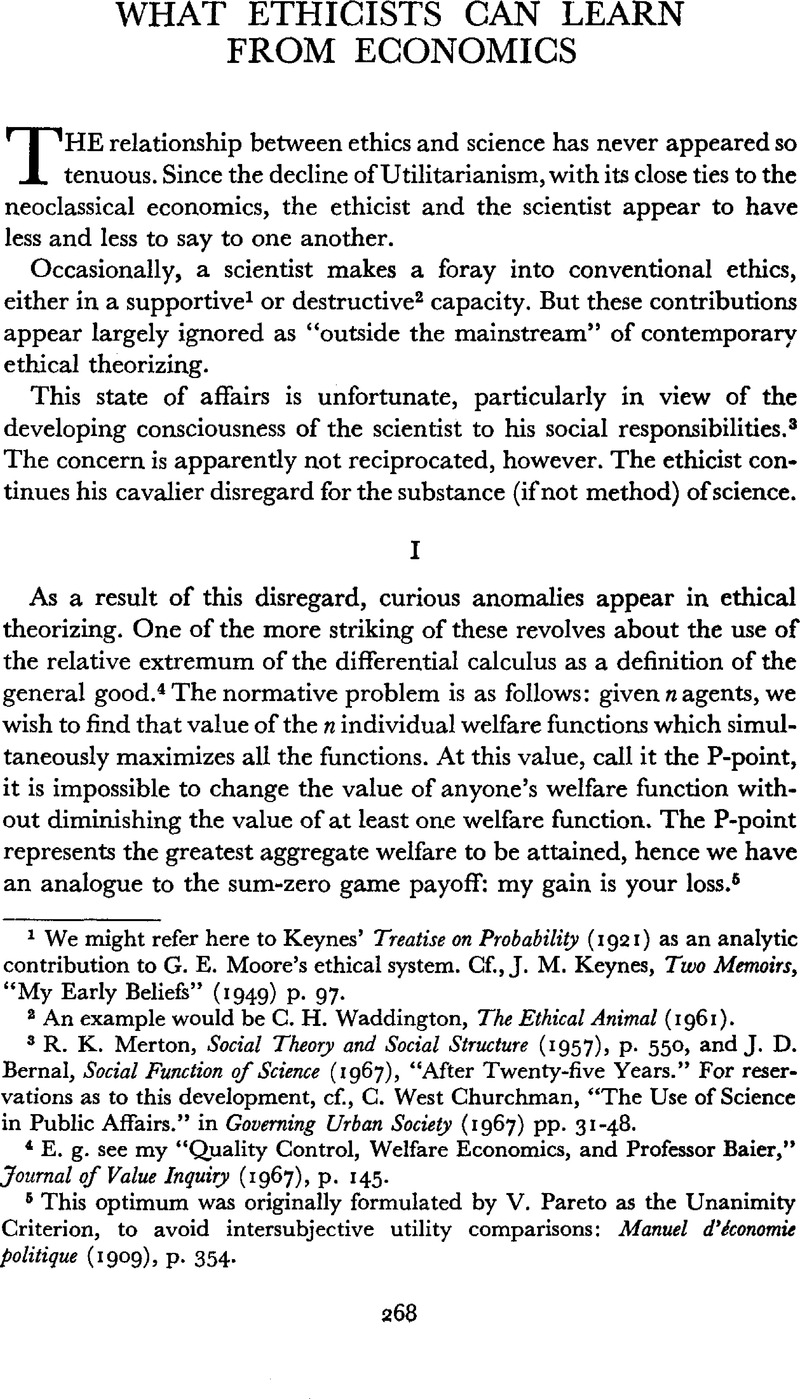No CrossRef data available.
Article contents
What Ethicists can learn from Economics
Published online by Cambridge University Press: 09 June 2010
Abstract

- Type
- Discussion/Note
- Information
- Dialogue: Canadian Philosophical Review / Revue canadienne de philosophie , Volume 7 , Issue 2 , September 1968 , pp. 268 - 272
- Copyright
- Copyright © Canadian Philosophical Association 1968
References
1 We might refer here to Keynes' Treatise on Probability (1921) as an analytic contribution to G. E. Moore's ethical system. Cf., J. M. Keynes, Two Memoirs, “My Early Beliefs” (1949) p. 97.
2 An example would be C. H. Waddington, The Ethical Animal (1961).
3 R. K. Merton, Social Theory and Social Structure (1957), p. 550, and J. D. Bernal, Social Function of Science (1967), “After Twenty-five Years.” For reservations as to this development, cf., C. West Churchman, “The Use of Science in Public Affairs.” in Governing Urban Society (1967) pp. 31–48.
4 E. g. see my “Quality Control, Welfare Economics, and Professor Baier,” Journal of Value Inquiry (1967), p. 145.Google Scholar
5 This optimum was originally formulated by V. Pareto as the Unanimity Criterion, to avoid intersubjective utility comparisons: Manuel d'iconomie politique (1909), p. 354.
6 F. Y. Edgeworth, Mathematical Psychics (1881), p. 47. The best contemporary treatment of the competition and optimum thesis is Tjalling Koopmans “Allocation of Resources and the Price System”, Three Essays on the State of Economic Science (1957), pp. 41 ff.
7 An early argument along these lines is J. Althusius, Politico Methodice Digesta (1614), where he describes the “necessitas communicandorum necessariorum” (I, 26) among agents “omnes omnium similes sunt” (VI, 40), etc. and the (resultant) symbiotic community. This is probably the best expression of the social contract prior to Hume. Alexander, S. S. has recently characterized this as “cooperative egoistic hedonism” and “an alliance among monads”, in Human Values and Economic Policy, ed. Hook, S. (1967), p. 108.Google Scholar
8 For a more extensive discussion of the conditions here, cf. Tisdell, C. “Some Bounds upon the Pareto Optimality of Group Behavior,” Kyklos Vol. XIX (1966), pp. 81–105.CrossRefGoogle Scholar
9 Varieties of Goodness (1963): all citations not otherwise specified are to this volume.
10 V. Pareto, op. cit., p. 354. cf. also p. 157: « Nous avons proposé de désigner l'utilité économique par le mot ophélimité. » To Pareto, ophélimité is subjective value or utility, cf. Cours d'economie politique (1896), I §7, and Mind and Society (1935) §2271. We propose, however, structural, not substantive, similarity between von Wright and Pareto. They are both unanimity quasi-orderings, a type of mathematical optimum developed by Kenneth Arrow, Social Choice and Individual Values (1966), pp. 34–36.
11 Given the neo-cardinalist thesis of F. P. Ramsey, et al., the social welfare optimum could be defined by Ω max = Σi=lu i
where u t is the expected utility of the ith member of a society of n-agents. In maximizing this function, there could (and undoubtedly would) arise occasions where the utility change for j is positive, a resultant utility change for k is negative (thus violating the Unanimity Criterion), and if Δu i>Δu kceteris paribus, then Σ is increased.
12 See D. Braybrooke's rather curious congratulation in Human Values and Economic Policy, op. cit., p. 237–8, note 18.


